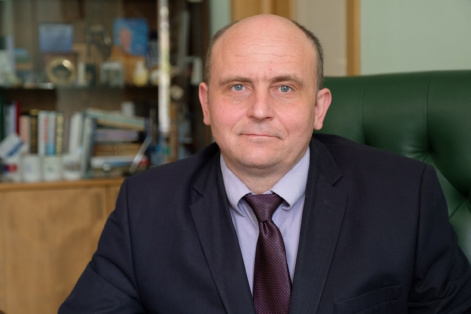Mystery of living leaves, mega grants and solenoids
4 June 2021 г.

The conversation begins with a short excursion. In the hall of the Institute of Physics, there are several expositions dedicated to its directors, Leonid Vasilyevich Kirensky and Kirill Sergeevich Alexandrov, and to its employees, those who fought on the fronts of the Great Patriotic War, and in front of the intstitute there are two monuments.
- Leonid Kirensky died in 1969, he was only 60 years old. The Regional Committee of the CPSU (Communist party) allowed us to bury the scientist right next to the institute, an unprecedented case. Not knowing that this is not just a monument, but a burial place, the newlyweds are photographed here. And next to it is the monumental structure called "Solenoid" by Nikolai Silis. Leonid Vasilyevich was an extraordinary person, he was friends with the artists of the sixties, including the author of the sculpture. Nikolay Silis died in 2018, at the age of 90.
- Solenoid, what is it?
- This is a device which generates an artificial magnetic field. Interestingly, the sculpture Solenoid was created at the time of attacks on "formalism" in art, and scientists came out in defense of the sculpture: they wrote a letter to the Moscow branch of the Union of Artists, in which they said that the sculptor embodied "superstrong magnetic fields" in his art work.
Magnetism is the area of Kirensky's scientific activity and one of the main directions of the research of our institute. Another important direction is optics, and here in our exposition of veterans of the Great Patriotic War there is a stand dedicated to Anatoly Vasilyevich Korshunov, one of the pioneers of optical research in the region.
There are three portraits on the wall in the office of the director of the Institute of Physics, Dmitry Balaev. These are Academicians Leonid Kirensky, Ivan Terskov, and Kirill Alexandrov. All of them in different years were the directors of the Institute of Physics.
- Leonid Kirensky had the most difficult time. It was Leonid Vasilyevich who "broke the formation of the institute through" in Krasnoyarsk. The founder of our institute was born in Yakutia and came here shortly before the war, by assignment he ended up in a pedagogical institute, where he created a magnetic laboratory. Kirensky took part in the development and production of instruments necessary for the analysis of steel, the metal with special properties was then used in our factories to forge Victory in the War. Even at that difficult time, the scientist managed to buy electromagnetic installations, equipment, and after the war the laboratory started working at full capacity. Having defended his doctoral thesis, Leonid Vasilyevich began to promote the idea of creating an academic Institute of Physics in our country. As often happens, at first, in 1953, he was refused. But three years later, in October 1956, a positive decision was made.
- At that time there were already academic institutes in Novosibirsk?
- No. Our Institute of Physics is a little older than Akademgorodok in Novosibirsk. Institute of Physics was located first in Marx street, 42a. And then, the construction began in our Akademgorodok; Kirensky personally chose the location both for the district and for the institute. They built the main building, a cryogenic station, and then, other scientific institutions and residential buildings appeared.
By 1980, the Institute of Biophysics got separated from the Institute of Physics. At that time, Academician Terskov was already the director. And since 1981, the institute was headed by Kirill Sergeevich Alexandrov. However, while science developed in the 1980s, the 1990s, of course, turned out to be difficult. It is worth noting here that, despite the difficulties, we have retained our position.
- People worked without money, for the sake of research and science ..
- In fact, if you do what you love, then money appears. In general, as a researcher, I felt that the state had a desire to develop science, approximately in the middle of the 2000s. Then, the opportunity opened up to buy new installations, and to hire new specialists. Funding increased, it became easier, and young people began to be interested in research work at the institute.
The next director of the Institute of Physics was the physicist Vasily Filippovich Shabanov, now he is the scientific Supervisor of the Federal Research Center of the Krasnoyarsk Science Center of SB RAS, the founder of the scientific school.
Share:
